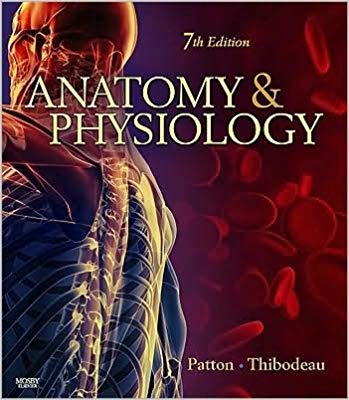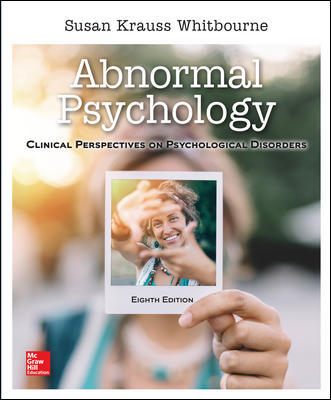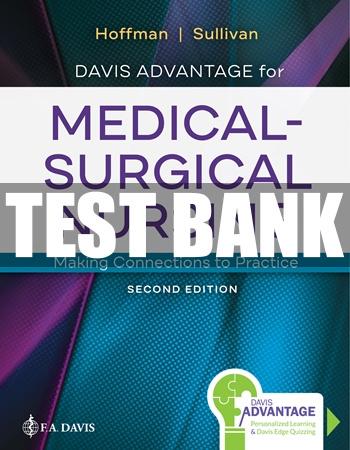In Stock
Test Bank for Introduction to Critical Care Nursing 7th Edition by Sole
By: Sole
Edition: 7th Edition
Format: Downloadable ZIP Fille
Resource Type: Test bank
Duration: Unlimited downloads
Delivery: Instant Download
$15.00
Test Bank for Introduction to Critical Care Nursing 7th Edition by Sole
Chapter 05: Comfort and Sedation
Sole: Introduction to Critical Care Nursing, 7th Edition
MULTIPLE CHOICE
1.Nociceptors differ from other nerve receptors in the body in that they:
| a. | adapt very little to continual pain response. |
| b. | inhibit the infiltration of neutrophils and eosinophils. |
| c. | play no role in the inflammatory response. |
| d. | transmit only the thermal stimuli. |
ANS: A
Nociceptors are stimulated by mechanical, chemical, or thermal stimuli. Nociceptors differ from other nerve receptors in the body in that they adapt very little to the pain response. The body continues to experience pain until the stimulus is discontinued or therapy is initiated. This is a protective mechanism so that the body tissues being damaged will be removed from harm. Nociceptors usually initiate inflammatory responses near injured capillaries. As such, the response promotes infiltration of injured tissues with neutrophils and eosinophils.
DIF: Cognitive Level: Remember/Knowledge REF: p. 54
OBJ: Discuss the physiology of pain and anxiety.
TOP: Nursing Process Step: Assessment
MSC: NCLEX Client Needs Category: Physiological Integrity
2. A postsurgical patient is on a ventilator in the critical care unit. The patient has been tolerating the ventilator well and has not required any sedation. On assessment, the nurse notes the patient is tachycardic and hypertensive with an increased respiratory rate of 28 breaths/min. The patient has been suctioned recently via the endotracheal tube, and the airway is clear. The patient responds appropriately to the nurse’s commands. The nurse should:
| a. | assess the patient’s level of pain. |
| b. | decrease the ventilator rate. |
| c. | provide sedation as ordered. |
| d. | suction the patient again. |
ANS: A
Pulse, respirations, and blood pressure frequently result from activation of the sympathetic nervous system by the pain stimulus. Because the patient is postoperative, the patient should be assessed for the presence of pain and need for pain medication. Decreasing the ventilator rate will not help in this situation. Providing sedation may calm the patient but will not solve the problem if the physiological changes are from pain. The patient has just been suctioned and the airway is clear. There is no need to suction again.
DIF: Cognitive Level: Analyze/Analysis REF: p. 55
OBJ: Describe the positive and negative effects of pain and anxiety in critically ill patients.
TOP: Nursing Process Step: Assessment
MSC: NCLEX Client Needs Category: Physiological Integrity
3. The assessment of pain and anxiety is a continuous process. When critically ill patients exhibit signs of anxiety, the nurse’s first priority is to
| a. | administer antianxiety medications as ordered. |
| b. | administer pain medication as ordered. |
| c. | identify and treat the underlying cause. |
| d. | reassess the patient hourly to determine whether symptoms resolve on their own. |
ANS: C
When patients exhibit signs of anxiety or agitation, the first priority is to identify and treat the underlying cause, which could be hypoxemia, hypoglycemia, hypotension, pain, or withdrawal from alcohol and drugs. Treatment is not initiated until assessment is completed. Medication may not be needed if the underlying cause can be resolved.
DIF: Cognitive Level: Apply/Application REF: p. 70 | Table 5-11
OBJ: Describe methods and tools for assessing pain and anxiety in the critically ill patient.
TOP:Nursing Process Step: Assessment
MSC: NCLEX Client Needs Category: Physiological Integrity
4.Both the electroencephalogram (EEG) monitor and the Bispectral Index Score (BIS) or Patient State Index (PSI) analyzer monitors are used to assess patient sedation levels in critically ill patients. The BIS and PSI monitors are simpler to use because they
| a. | can be used only on heavily sedated patients. |
| b. | can be used only on pediatric patients. |
| c. | provide raw EEG data and a numeric value. |
| d. | require only five leads. |
ANS: C
The BIS and PSI have very simple steps for application, and results are displayed as raw EEG data and the numeric value. A single electrode is placed across the patient’s forehead and is attached to a monitor. These monitors can be used in both children and adults and in patients with varying levels of sedation.
DIF: Cognitive Level: Understand/Comprehension REF: p. 60
OBJ: Describe methods and tools for assessing pain and anxiety in the critically ill patient.
TOP:Nursing Process Step: Assessment
MSC: NCLEX Client Needs Category: Physiological Integrity
5.The nurse is caring for a patient who requires administration of a neuromuscular blocking agent to facilitate ventilation with nontraditional modes. The nurse understands that neuromuscular blocking agents provide:
| a. | antianxiety effects. |
| b. | complete analgesia. |
| c. | high levels of sedation. |
| d. | no sedation or analgesia. |
ANS: D
Neuromuscular blocking (NMB) agents do not possess any sedative or analgesic properties. Patients who receive NMBs must also receive sedatives and pain medication.
DIF: Cognitive Level: Remember/Knowledge REF: p. 72
OBJ: Discuss assessment and management challenges in subsets of critically ill patients.
TOP:Nursing Process Step: Implementation
MSC: NCLEX Client Needs Category: Physiological Integrity
6.The patient is receiving neuromuscular blockade. Which nursing assessment indicates a target level of paralysis?
| a. | Glasgow Coma Scale score of 3 |
| b. | Train-of-four yields two twitches |
| c. | Bispectral index of 60 |
| d. | CAM-ICU positive |
ANS: B
A train-of-four response of two twitches (out of four) using a peripheral nerve stimulator indicates adequate paralysis. The Glasgow Coma Scale does not assess paralysis; it is an indicator of consciousness. The bispectral index provides an assessment of sedation. The CAM-ICU is a tool to assess delirium.
DIF: Cognitive Level: Remember/Knowledge REF: p. 73
OBJ: Discuss assessment and management challenges in subsets of critically ill patients.
TOP:Nursing Process Step: Assessment
MSC: NCLEX Client Needs Category: Physiological Integrity
7.The nurse is concerned that the patient will pull out the endotracheal tube. As part of the nursing management, the nurse obtains an order for
| a. | arm binders or splints. |
| b. | a higher dosage of lorazepam. |
| c. | propofol. |
| d. | soft wrist restraints. |
ANS: D
The priority in caring for agitated patients is safety. The least restrictive methods of keeping the patient safe are appropriate. If possible, the tube or device causing irritation should be removed, but if that is not possible, the nurse must prevent the patient from pulling it out. Restraints are associated with an increased incidence of agitation and delirium. Therefore, restraints should not be used unless as a last resort for combative patients. The least amount of sedation is also recommended; therefore, neither increasing the dosage of lorazepam nor adding propofol is indicated and would be likely to prolong mechanical ventilation.
DIF: Cognitive Level: Apply/Application REF: p. 61
OBJ:Identify nonpharmacological and pharmacological strategies to promote comfort and reduce anxiety.TOP:Nursing Process Step: Planning
MSC: NCLEX Client Needs Category: Safe and Effective Care Environment








